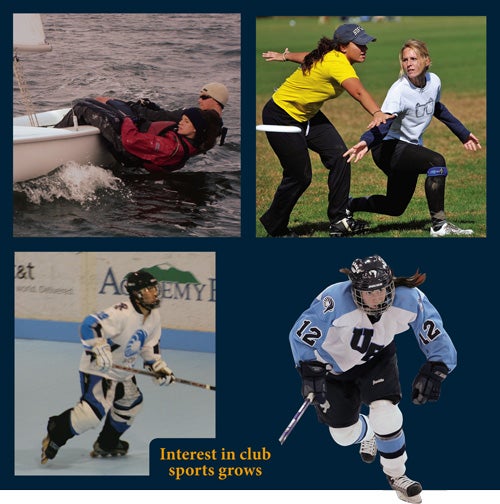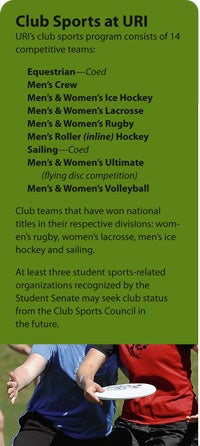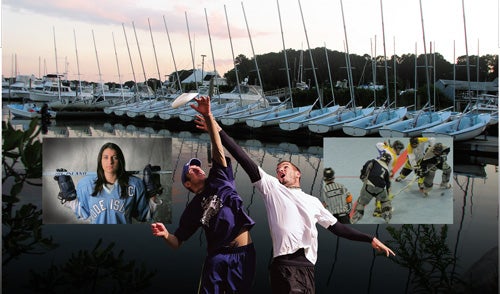Many Ways to Play

For practices, they skate at midnight at a rink in Warwick.
Ranked eighth in the country, their “home rink” is in Glastonbury, Conn.
Wait a minute, how can that make sense? URI’s hockey teams play and practice at the Bradford R. Boss Arena on the Kingston Campus, so what’s going on here?
Well, this tale isn’t just about ice hockey. We’re talking about inline roller hockey and the other 13 University club sports, many of which are national powers. Close to 450 students compete in club sports, compared with 500 who compete at the intercollegiate level.
 Inline hockey, which competes at the Division I level in the Eastern Collegiate Roller Hockey Association as part of the National Collegiate Roller Hockey Association, posted a 7-1-2 record and was ranked No. 8 nationally at the close of 2008. In 2007, the team made it to the national championship before losing to Lindenwood University; last year it reached the national quarterfinals.
Inline hockey, which competes at the Division I level in the Eastern Collegiate Roller Hockey Association as part of the National Collegiate Roller Hockey Association, posted a 7-1-2 record and was ranked No. 8 nationally at the close of 2008. In 2007, the team made it to the national championship before losing to Lindenwood University; last year it reached the national quarterfinals.
“This is one of the best teams we’ve ever had,” said Brendan Nelson, a junior accounting major and assistant captain from Smithtown, N.Y. “We’re representing our school, so we want to compete well.”
Justin Lundh, fellow junior assistant captain and a marketing major from Cranston, said: “Our members are probably a lot closer than other teams, because when we go on the road, we don’t stay in hotels. Parents in the areas where we play put us up.”
Like all other club athletes, the 13 members of the inline team pay to play through a registration fee.
If team members don’t raise enough money to supplement the Student Senate allocation gas, food and other expenses come out of their pockets. Oh, and they also drive their own cars to games in Long Island, Pennsylvania, and Connecticut.
“We’ve had games where we have had to drive through snowstorms,” said Earl Lundh, the inline coach and Justin’s father.
Despite the grueling hours and travel, strong grades are always the first priority, the coach said. “Ninety percent of why I do this is because of the guys—I wouldn’t do this if it weren’t a great group of guys. I have them at my house for dinner all the time,” Lundh said.
Such experiences are similar for other club sports, including URI’s powerful hockey programs and its sailing program, which last fall captured its 11th Kennedy Cup, college sailing’s national big boat championship. Club sports like sailing and crew have produced URI’s only Olympic medalists in many decades, and men’s ice hockey sent four representatives to the World University Winter Games in China in February.
A component of the Division of Student Affairs, the club sports program relies on $230,000 allocated annually by the URI Student Senate.
That support is due in large part to the efforts of former recreational services director Art Tuveson, currently assistant director of athletics, who convinced the Student Senate in the 1980s that club sports could be extremely successful.
“Now URI is one of the top 5 percent of universities in the country for our support of club sports,” said Club Sports Coordinator Brian Fetky, who assists the organizations with management, policy creation and enforcement, public relations and marketing, fund raising and travel arrangements. “The Senate covers about 40 percent of club sports’ funding.”
Some programs like ice hockey, crew, and sailing that have benefited from aggressive fund raising over the years have their own top-flight facilities that are on a par with many varsity programs. Men’s rowing and ice hockey are even supported by endowments.
Then there are sports like inline hockey which, like ice hockey, crew, and sailing in earlier decades, struggle with modest budgets and a lack of campus or nearby facilities.
Women’s ice hockey coach Beth McCann leads a team that in December was ranked No. 1 in Division 1 of the American Collegiate Hockey Association. But she remembers her first team in 1999 when it practiced and played in West Warwick. “That first year, we started with nine players, but the league required 12,” McCann said. “I had to go out to recruit students on campus, and some I had to teach how to skate.”
Now the team is attracting some of the best women’s hockey talent from Rhode Island and the region. This year it has its first international player, freshman Johanna Leskinen of Finland.
Leskinen said there is nothing like college hockey in Finland. “I played on women’s clubs, and when I was 14, I had a teammate who was 33,” said the former member of Finland’s national women’s team.
The business management major found URI on the Web while scouting schools offering hockey. “I was looking at East Coast schools, and when I found URI, I started emailing coach McCann. I came for a visit last summer, and when I saw the Boss Arena, I was so impressed. In Finland, we never even had our own lockers.”
Ice hockey team members also run fund-raising events to supplement their budget. A few weeks before winter break, team members were outside the bookstore wrapping holiday gifts for $2 a parcel.
“There is more talent coming in every year,” said Jolene Rambone, a junior captain and kinesiology major from Burrillville. “It’s a totally different game than when I first came to URI.”
Fellow captain and kinesiology major Kate Garcia, a senior forward from Scituate, said, “We play at a very competitive level at the club level, but we also play Division 1 and Division 3 varsity teams.”
“It’s been great so far,” she added. “From the beginning, the team helped me feel right at home.”
Speaking of team chemistry, the members of URI ultimate [flying disc] teams go to great lengths to forge great bonds.
Each year for spring break, the club hires a van to drive to Georgia where team members stay in a rented house for a weeklong tournament.
Planning major road trips and hosting tournaments is nothing unusual for the club. It relies on captains Tom Confort, Isaac Peters-Cooper, Kayla Rivard, and Kellie Watermam, as well as Adam Crawley ’08, a former captain, to manage the club and develop tournaments. So far, the players have done it all without a coach, but they hope to have one in the spring.
Because the sport has become so popular, URI has two men’s teams and a women’s team. The sport combines the movement and athletic endurance of soccer with the aerial passing skills of football. Ultimate is played by two seven-player squads with a plastic disc on a field similar to football. The object of the game is to score by catching a pass in the opponent’s end zone. Players also call their own fouls.
“The thing I am most proud of is playing on a single 12-member coed team (that has now become three teams) when I was a freshmen,” said Crawley, a Barrington resident who earned his bachelor’s degree in political science and is now taking biology courses in preparation for a master’s degree in public health.
“We’re really excited this year,” co-captain Confort said, “because we are bringing all three teams to the Georgia tournament.”
Women’s co-captain Waterman said team members are hoping to make the regional playoffs for the first time in their three-year history. And not only are they going to Georgia, they’re also driving to a prestigious spring tourney in Louisiana.
“I had never been on a team sport, and it’s just so amazing,” said the junior chemical engineering major who ran track and cross country at Cumberland High School. “I love being a captain. I have a really strong passion for the sport, and I hope to pass this along.”
In the fall, URI hosted a tournament featuring 16 A teams, 10 B teams, and eight women’s squads. In the spring, it will host an even bigger tournament and compete for berths in national playoffs. Fees paid by participating teams are the club’s major funding source.
“Because we organize our tournaments, our travel, and our fund raising, we have an opportunity to flourish in areas of leadership, budgeting, and motivating our teammates,” said Confort, an English major from Sudbury, Mass. “I have made friends through ultimate, and I expect they will be lifelong.”
By Dave Lavallee ’79, M.P.A. ‘87

 Home
Home Browse
Browse Close
Close Events
Events Maps
Maps Email
Email Brightspace
Brightspace eCampus
eCampus


